‘This feels normal,’ Tayler Stiles thinks, beginning to get loose in the bullpen. Then, he puts on his new mask, protecting his face, where he was hit with a line drive. ‘Oh, this feels great.’
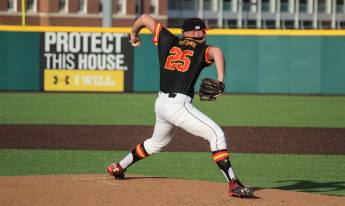
After 316 days, two major surgeries and countless hours of rehab, Stiles is preparing to get back on the mound.
The Bowie, Md., native exits the bullpen and heads toward the hill for the top of the sixth inning, Maryland leading 10-7. It’s his first appearance of the season, coming on February 28, during the final game of a three-game series with Rhode Island.
The Terrapins are wearing their black jerseys with red numbers and gold trim. White pants with a lone black stripe down the leg; black stirrups with two red stripes divided by one gold band above an Under Armor logo. It’s the exact ones the Terps—and Stiles—donned less than 10 months earlier, the last time Stiles pitched in a game.
Upon hearing his name announced, the crowd rises to its feet and gives Stiles a standing ovation.
A FASTBALL LOW AND AWAY
It’s April 18, 2015, and Stiles is preparing to make his sixth start of the season. The then-sophomore southpaw had pitched his way into the weekend rotation and was set to make his third straight Saturday start.
Leadoff hitter Dustin Vaught—the third baseman for the visiting Cal St. Fullerton Titans—stepped into the right-handed batter’s box. Junior catcher Kevin Martir gave Stiles his first sign.
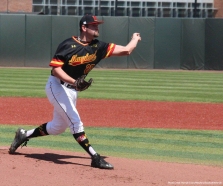
“It was a fastball low and away,” Martir, now in the Houston Astros organization, said. “And he missed for ball one.”
Stiles caught the return throw from Martir and walked back up to the mound. In his usual routine, he leaned toward the plate to get the sign, the ball behind his back, rotating in his left hand, his glove resting on his right leg. Martir called for the same pitch— a fastball, low and away.
The southpaw came set, feet pointed toward first base, glove level with his chest. He went into his windup, and delivered. The ball exploded off Vaught’s bat straight back at Stiles, hitting him flush in the left side of his face.
“I throw the pitch, he hits the ball, next thing I know I’m on the ground,” Stiles said. “I’ve got this loud ringing in my head and the first thing I remember is, the only way I could get [the ringing] out of my head is if I yelled.”
The ball came off of Vaught’s bat at an estimated 100 mph, leaving no time for the left-hander to react.
With the stadium hushed, Stiles’ screams could be heard all around the ballpark as he writhed on the mound. The first one to him was the Terps’ former athletic trainer Alex Bazink.
“Instincts take over in the moment; you don’t really think about what’s happening,” Bazink, who is now an athletic trainer at Dickinson College, said. “It was a scary situation. Looking at [Kevin] Martir as I was running out I knew it was bad, and by the time I got out there he was already bleeding on the mound.”
Bazink went into emergency mode, calling an ambulance while trying keep Stiles upright, simultaneously working to stop the bleeding with towels.
Stiles, who maintained consciousness throughout the ordeal, initially thought he was blind—he couldn’t see out of his left eye. With his right eye, however, he saw everything.
“I could see all of it,” Stiles said. “I could see the blood on the towel, I could see the blood dripping down onto my jersey and I could see it dripping down on to the dirt on the mound. It was everywhere.”
FROM THE FIELD TO THE HOSPITAL
Tayler’s father, Brent, was in attendance, watching from his usual spot in the top row of the stands on the third base side with other parents.
“The initial thought was, ‘You’ve been hit. How many times have you been hit? You’re a pitcher, you always get hit, just get up,’” Brent Stiles said. “I was waiting for him to get up and it just didn’t happen.”
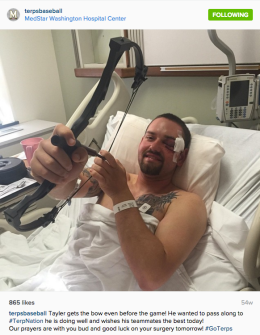
Brent was the only member of the Stiles family there that day. Christine Stiles, Tayler’s mother, was in Owings Mills, Md., watching Melanie—Tayler’s younger sister—play soccer in her high school game. It was on her way back—and to the Terps baseball game—that Christine heard what happened, listening to the game live on the Maryland Baseball Network while driving on the Beltway.
She repeatedly called Brent, who couldn’t pick up because he had gone down to the field to help Bazink, Martir and other Terps support and take care of Stiles. When Brent finally called back, it was a brief conversation.
‘I’m on the field with Tayler. He got hit in the face. The ambulance is coming.’
The two hung up, as Brent continued to help Tayler and Christine continued to make her way toward the field. They reconnected on the phone soon after, and Brent told Christine where the ambulance was headed.
As Christine drove toward the hospital, she stopped at a traffic light near College Park and watched as an ambulance sped by, crossing through the intersection in front of her. It was the ambulance carrying her son to MedStar Hospital. Christine turned and followed it.
PLAYING FOR TAYLER
Then-senior LHP Rob Galligan was tabbed to make the first start of his career in the series finale the next day. As he helped Stiles while the ambulance came, Terps pitching coach Jimmy Belanger came over, tapped him on the shoulder and told him to start warming up.
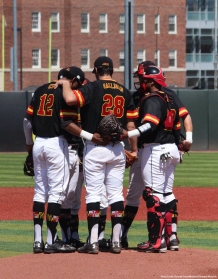
Before the game restarted, Galligan saw third baseman Jose Cuas shaken up, and the other infielders as well. He brought them all to the mound, where they embraced in a pseudo group hug.
“Who cares about the result, who cares what happens?” Galligan said to his teammates. “We’re playing for Tayler and we’re going to get this victory.”
Galligan was familiar with what Stiles was going through. Back when he was a sophomore in high school, he was hit in the face during a February batting practice. He fractured his nose in seven places, completely shattered his cheekbone and had a hole in his sinus. After facial reconstructive surgery, he went through rehab and returned to playing just a few months later. Galligan angered his doctor by refusing protective headgear—he didn’t want the reminder of what had happened.
“The second or minute you have that sense of doubt, or sense that urgency or fear, you can’t do anything,” he said.
Invigorated by his injured teammate, Galligan tossed six innings of one-run ball, striking out six, while the offense put up nine runs to win 9-5. It was not only Galligan’s first win of the season, but also the first win of his collegiate career.
“DO YOU EVEN WANT TO PLAY ANYMORE?”
At the hospital, doctors had determined that Stiles needed to wait for surgery due to excess blood behind his eye. He had shattered the orbital bones around his left eye and had broken his zygomatic bone (cheekbone) as well.
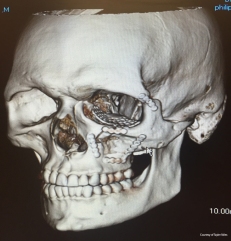
Just over a week after the injury, on April 27, Stiles underwent facial reconstructive surgery at the University of Maryland Medical Center in Baltimore, Md. He received over 25 medical screws in his face and a plate stabilizing the bottom of his eye socket.
After the procedure, Stiles began asking Brent and the doctors when he’d be able to play again. By his math, he should be ready to go in June, should the Terps still be playing.
“I’m thinking to myself, ‘do you even want to play anymore?’” Brent Stiles said. “It was never a doubt in his mind at all.”
Stiles wouldn’t have been the first one to hang up the spikes after an injury like his. Not only is the physical rehabilitation a tough process, but there’s a significant mental side to the recuperation as well. After getting hit in the face on the mound, how do you go back out there and pitch without the fear of it happening again in the back of your mind?
“I can’t even tell you how many people have told me ‘I don’t even know how you got back up on that mound,’” Stiles said. “That injury, that crazy event, is a one-in-a-million event. For it to happen to me again? My dad said if it happens to me again I’d have to play the lottery that day.”
He recognizes the effect his injury had on the people around him—teammates, coaches, family and even fans. Through it all, there was one reaction that stuck with him.
“There’s a kid, I don’t know his name; I don’t even know how he is,” Stiles recalls. “But someone told me he was at that game and to this day he still doesn’t pitch.”
He pauses and tries to fight back tears. The despair in his voice is clear.
“And that just sucks,” he says.
“I could see all of it. I could see the blood on the towel, I could see the blood dripping down onto my jersey and I could see it dripping down on to the dirt on the mound. It was everywhere.” – Tayler Stiles
Before Stiles could begin rehab, he needed to undergo more procedures to correct his vision—his eye hadn’t healed properly after the first surgery.
Stiles went to see ophthalmological specialists at the University of Maryland Eye Associates, whom diagnosed him with a macular hole in his retina, causing blurred and distorted vision. A month after his first surgery, Stiles underwent a non-invasive injection procedure as a means to correct his vision.
But, the issues persisted, so Stiles was faced with another major operation, a full vitrectomy. On June 3, Dr. Marena Patronas, the ophthalmologist, removed part of Stiles’ eye and repaired it, placing it back in its rightful place surrounded by a gas bubble that acts as a cast. For the procedure to work, Stiles was required to stay facedown for 12 straight days, thereby ensuring the bubble would remain in the proper place.
“All I could do was watch TV, eat, take showers and sleep,” Stiles said. “I took four showers a day because it was something to do.”
A few weeks later, Stiles was able to officially begin his rehab, lifting weights to regain lost muscle mass. He threw for the first time in the middle of the summer, tossing lightly with the Terps former strength and conditioning coach, Seth Diters. It was then that the two first began discussing protection for the upcoming season—the mask.
BEHIND THE MASK
On the mound against Rhode Island, Stiles wasn’t thinking about the batter or the game. His only thought was, ‘What are people going to think of this mask?’
The junior faced the top of the Rams’ lineup, starting with leadoff hitter Ryan Olmo. Stiles got Olmo to pop-out, and then retired the next two batters on a line-out and strikeout for a perfect frame.
The three outs alone did wonders for Stiles’ confidence, but redshirt freshman Andrew Bechtold helped as well.
“He came up to me inside the dugout and said, ‘Hey, guess what—the umpire just said you look like a bad ass out there with that mask on,’” Stiles said.
The mask may look familiar to some—it’s the same one worn by former NBA player Rip Hamilton for the entirety of his career and by Kobe Bryant for part of his career as well. In fact, Stiles’ mask comes from the same place, too.
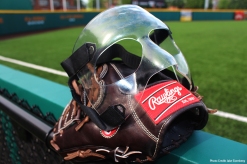
In August, the junior approached Ron Ohringer, the Maryland Athletics head equipment manager, asking about protective gear for his face. The two decided that a field hockey or women’s lacrosse-like cage was too restrictive and heavy and other similar masks limited his peripheral vision. So, Ohringer contacted Jeremy Murray, the director of Michigan Hand and Sports Rehabilitation Center and founder of Murray Masks, and told him about Stiles’ situation. A few weeks later, Stiles was on his way to Michigan to have his face molded.
The mask itself, at first glance, looks like it belongs in some kind of Phantom of the Opera-Batman hybrid. It’s made of clear plastic, and was tested to withstand tremendous impact. Murray put the mask on a dummy in front of a pitching machine and cranked it up to 100 mph. After 50 baseballs were flung at the mask, it revealed no scratches, dents or other imperfections. According to Stiles, the mask is just shy of bulletproof.
He first wore it in competition during the Terps’ Fall World Series, a three-game intrasquad series. Stiles was cleared to play for the final game of the series, entering in the later innings. He was more excited to play again and throw his pitches than nervous for them to get hit back at him.
“No fear,” he said. “Not even a little bit. The only thing different [was] that I’m wearing a mask now. “
THE BULLDOG
A look at Stiles’ shoulders tells the story of his personality and adversity.
On his right shoulder is a tattoo of a bulldog, snarling and growling down toward his bicep. In the bulldog’s teeth is a baseball, creeping out under the sleeve of his uniform on game days. ‘The Bulldog’ is a moniker for Stiles, one he’s had for several years.
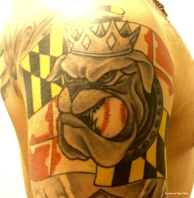
“He’s always been the fighter; ‘The Bulldog,’” Christine Stiles said. “He’s always been the person who will come back from an adversarial moment.”
It’s the tattoo on his left shoulder that depicts the adversity. On a shadowy background is a skull, identical to the one in his post-surgery x-ray, complete with the 25-plus screws and plate. Underneath it is text that reads, “It ain’t about how hard you hit. It’s about how hard you can get hit and keep moving forward.”
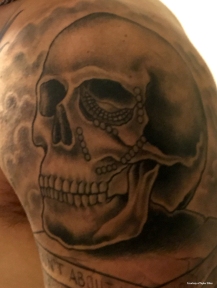
His teammates and coaches worry about Stiles more than he worries about himself. They ask him where his mask is and remind him to wear it, even when Stiles is just sitting in the dugout. A few weeks after his first appearance, a batted ball hit Stiles in the shin. As head coach John Szefc and athletic trainer Sven Pearson came out of the dugout to check on him, Stiles waved them off, telling them if it wasn’t his face, he was going to be all right.
“It is still a little scary,” Christine Stiles said. “Every time the ball gets hit back up the middle it scares the hell out of me. Even if it’s another pitcher, too.”
The junior’s ordeal is far from over. He still regularly sees an ophthalmologist and had laser eye surgery last month. Next week, he’ll go back to University of Maryland Eye Associates for another procedure to relieve pressure that’s damaging his optic nerve.
“I can get through anything after this, and that’s a good thing to know,” Stiles said. “That I’ve gone through—I think—the hardest part of my life and I was 20 years old when it happened.”
The mask and his tattoos remain a constant reminder of his journey. He carries his experiences with him wherever he goes, whether it be to class, the gym, or the mound. The ordeal shapes the pitcher he is—aggressive and fearless, like a bulldog.
[…] […]
LikeLike
[…] and countless hours of PT to return to the Terps in 2016 – 316 days after he was hit in the face, as chronicled by Jake Eisenberg of the Maryland Baseball Network. Alas, another injury sidelined Stiles in late April of 2016. The senior lefty rebounded again, […]
LikeLike
Hello,I read your new stuff named “A year removed from season-ending injury, Maryland Terrapins southpaw Tayler Stiles pitches without fear | Maryland Baseball Network” regularly.Your humoristic style is awesome, keep doing what you’re doing! And you can look our website about تحميل اغاني.
LikeLike